Exploring the Functional Properties of Leaves of Moringa oleifera Lam. Cultivated in Sicily Using Precision Agriculture Technologies for Potential Use as a Food Ingredient
Abstract
1. Introduction
2. Materials and Methods
2.1. Experimental Site and Sustainable Cultivation Protocols
2.2. Moringa oleifera Precision Farming
2.3. Moringa oleifera Leaves Collection, Drying, and Powder Production
2.4. Safety Evaluation by Culture-Dependent Approach
2.5. Culture-Independent Analysis of Bacterial Community
2.6. Preparation of the Powdered Moringa oleifera Leaves Extract
2.7. Content of Pigments and Polyphenol Compounds
2.8. Cellular Culture
2.9. Antioxidant Activity
2.9.1. Antioxidants Properties
2.9.2. Cellular Antioxidant Activity
2.10. Antiproliferative Activity
2.11. HPLC-DAD-MS/MS Analysis
2.12. Volatile Organic Compounds Analysis
2.13. Statistical Analysis
3. Results and Discussion
3.1. Moringa oleifera Optimal Harvest Time
3.2. Drying Curves
3.3. Microbial Count
3.4. Composition of Bacterial Communities
3.5. Content of Pigments and Polyphenol Compounds in Powdered Moringa oleifera Leaves
3.6. Phytochemical Composition
3.7. Antioxidant Properties
3.8. Antiproliferative Activity
3.9. Volatilome Composition
4. Conclusions
Author Contributions
Funding
Institutional Review Board Statement
Informed Consent Statement
Data Availability Statement
Conflicts of Interest
References
- Ballco, P.; Gracia, A. Tackling nutritional and health claims to disentangle their effects on consumer food choices and behaviour: A systematic review. Food Qual. Prefer. 2022, 101, 104634. [Google Scholar] [CrossRef]
- Pilati, M. National Recovery and Resilience Plans: Empowering the Green and Digital Transitions? EPC Discussion Paper; European Policy Centre: Brussels, Belgium, 2021. [Google Scholar]
- Liguori, G.; Greco, G.; Salsi, G.; Garofalo, G.; Gaglio, R.; Barbera, M.; Greco, C.; Orlando, S.; Fascella, G.; Mammano, M.M. Effect of the Gellan-Based Edible Coating Enriched with Oregano Essential Oil on the Preservation of the ‘Tardivo Di Ciaculli’ Mandarin (Citrus reticulate Blanco Cv. Tardivo Di Ciaculli). Front. Sustain. Food Syst. 2024, 8, 1334030. [Google Scholar] [CrossRef]
- Comunian, T.A.; Silva, M.P.; Souza, C.J. The use of food by-products as a novel for functional foods: Their use as ingredients and for the encapsulation process. Trends Food Sci. Technol. 2021, 108, 269–280. [Google Scholar] [CrossRef]
- Ayeni, E.A.; Gong, Y.; Yuan, H.; Hu, Y.; Bai, X.; Liao, X. Medicinal plants for anti-neurodegenerative diseases in West Africa. J. Ethnopharmacol. 2022, 285, 114468. [Google Scholar] [CrossRef]
- Rani, J.; Dhull, S.B.; Rose, P.K.; Kidwai, M.K. Drug-induced liver injury and anti-hepatotoxic effect of herbal compounds: A metabolic mechanism perspective. Phytomedicine 2024, 122, 155142. [Google Scholar] [CrossRef]
- Rouhi-Boroujeni, H.; Heidarian, E.; Rouhi-Boroujeni, H.; Deris, F.; Rafieian-Kopaei, M. Medicinal plants with multiple effects on cardiovascular diseases: A systematic review. Curr. Pharm. Des. 2017, 23, 999–1015. [Google Scholar] [CrossRef]
- Wink, M. Current understanding of modes of action of multicomponent bioactive phytochemicals: Potential for nutraceuticals and antimicrobials. Annu. Rev. Food Sci. Technol. 2022, 13, 337–359. [Google Scholar] [CrossRef]
- Yang, M.; Tao, L.; Kang, X.R.; Wang, Z.L.; Su, L.Y.; Li, L.F.; Gu, F.; Zhao, C.C.; Sheng, J.; Tian, Y. Moringa oleifera Lam. leaves as new raw food material: A review of its nutritional composition, functional properties, and comprehensive application. Trends Food Sci. Technol. 2023, 138, 399–416. [Google Scholar] [CrossRef]
- Gupta, S.; Jain, R.; Kachhwaha, S.; Kothari, S.L. Nutritional and medicinal applications of Moringa oleifera Lam.—Review of current status and future possibilities. J. Herb. Med. 2018, 11, 1–11. [Google Scholar] [CrossRef]
- Boopathi, N.M.; Abubakar, B.Y. Botanical Descriptions of Moringa spp. In The Moringa Genome; Springer International Publishing: Cham, Switzerland, 2021; pp. 11–20. [Google Scholar]
- Meireles, D.; Gomes, J.; Lopes, L.; Hinzmann, M.; Machado, J. A review of properties, nutritional and pharmaceutical applications of Moringa oleifera: Integrative approach on conventional and traditional Asian medicine. Adv. Tradit. Med. 2020, 20, 495–515. [Google Scholar] [CrossRef]
- Camilleri, E.; Blundell, R. A comprehensive review of the phytochemicals, health benefits, pharmacological safety and medicinal prospects of Moringa oleifera. Heliyon 2024, 10, e27807. [Google Scholar] [CrossRef]
- Leone, A.; Fiorillo, G.; Criscuoli, F.; Ravasenghi, S.; Santagostini, L.; Fico, G.; Spadafranca, A.; Battezzati, A.; Schiraldi, A.; Pozzi, F.; et al. Nutritional characterization and phenolic profiling of Moringa oleifera leaves grown in Chad, Sahrawi Refugee Camps, and Haiti. Int. J. Mol. Sci. 2015, 16, 18923–18937. [Google Scholar] [CrossRef]
- Yassa, H.D.; Tohamy, A.F. Extract of Moringa oleifera leaves ameliorates streptozotocin-induced diabetes mellitus in adult rats. Acta Histochem. 2014, 116, 844–854. [Google Scholar] [CrossRef]
- Vázquez-León, L.A.; Páramo-Calderón, D.E.; Robles-Olvera, V.J.; Valdés-Rodríguez, O.A.; Pérez-Vázquez, A.; García-Alvarado, M.A.; Rodríguez-Jimenes, G.C. Variation in bioactive compounds and antiradical activity of Moringa oleifera leaves: Influence of climatic factors, tree age, and soil parameters. Eur. Food Res. Technol. 2017, 243, 1593–1608. [Google Scholar] [CrossRef]
- Mashamaite, C.V.; Ramatsitsi, M.N.; Manyevere, A. Moringa oleifera Lam.: A versatile climate-smart plant for nutritional security and therapeutic usage in semi-arid regions. J. Agric. Food Res. 2024, 16, 101217. [Google Scholar] [CrossRef]
- Anwar, F.; Latif, S.; Ashraf, M.; Gilani, A.H. Moringa oleifera: A food plant with multiple medicinal uses. Phytother. Res. 2007, 21, 17–25. [Google Scholar] [CrossRef]
- Rivas, R.; Oliveira, M.T.; Santos, M.G. Three cycles of water deficit from seed to young plants of Moringa oleifera woody species improves stress tolerance. Plant Physiol. Biochem. 2013, 63, 200–208. [Google Scholar] [CrossRef]
- Conte, L.; Prakofjewa, J.; Floridia, T.; Stocco, A.; Comar, V.; Gonella, F.; Lo Cascio, M. Learning from farmers on potentials and limits for an agroecological transition: A participatory action research in Western Sicily. Front. Environ. Sci. 2024, 12, 1347915. [Google Scholar] [CrossRef]
- Gaglio, R.; Barbaccia, P.; Barbera, M.; Restivo, I.; Attanzio, A.; Maniaci, G.; Di Grigoli, A.; Francesca, N.; Tesoriere, L.; Bonanno, A.; et al. The use of winery by-products to enhance the functional aspects of the fresh ovine “Primosale” cheese. Foods 2021, 10, 461. [Google Scholar] [CrossRef]
- Peres, D.J.; Bonaccorso, B.; Palazzolo, N.; Cancelliere, A.; Mendicino, G.; Senatore, A. A dynamic approach for assessing climate change impacts on drought: An analysis in Southern Italy. Hydrol. Sci. J. 2023, 68, 1213–1228. [Google Scholar] [CrossRef]
- Shulner, I.; Asaf, E.; Ben-Simhon, Z.; Cohen-Zinder, M.; Shabtay, A.; Peleg, Z.; Lati, R.N. Optimizing weed management for the new super-forage Moringa oleifera. Agronomy 2021, 11, 1055. [Google Scholar] [CrossRef]
- Kottek, M.; Grieser, J.; Beck, C.; Rudolf, B.; Rubel, F. World map of the Köppen-Geiger climate classification updated. Meteorol. Z. 2006, 15, 259–263. [Google Scholar] [CrossRef]
- Mammano, M.M.; Comparetti, A.; Greco, C.; Orlando, S. A model of Sicilian environmentally friendly multifunctional farm for soil protection. In Proceedings of the Conference of the Italian Society of Agricultural Engineering (AIIA): Biosystems Engineering Towards the Green Deal, Palermo, Italy, 19–22 September 2022; pp. 687–695. [Google Scholar]
- Greco, C.; Catania, P.; Orlando, S.; Calderone, G.; Mammano, M.M. Rosemary biomass estimation from UAV multispectral camera. In Proceedings of the Conference of the Italian Society of Agricultural Engineering (AIIA): Biosystems Engineering Promoting Resilience to Climate Change, Padova, Italy, 14–19 June 2024. [Google Scholar]
- Comparetti, A.; Greco, C.; Orlando, S.; Ciulla, S.; Mammano, M.M. Comparison of mechanical, assisted and manual harvest of Origanum vulgare L. Sustainability 2022, 14, 2562. [Google Scholar] [CrossRef]
- Greco, C.; Catania, P.; Orlando, S.; Vallone, M.; Mammano, M.M. Assessment of vegetation indices as tool to decision support system for aromatic crops. In Proceedings of the Conference SHWA: Safety, Health and Welfare in Agriculture and Agro-Food Systems, Ragusa, Italy, 6–9 September 2023; pp. 322–331. [Google Scholar]
- Miceli, A.; Gaglio, R.; Francesca, N.; Ciminata, A.; Moschetti, G.; Settanni, L. Evolution of shelf life parameters of ready-to-eat escarole (Cichorium endivia var. latifolium) subjected to different cutting operations. Sci. Hortic. 2019, 247, 175–183. [Google Scholar]
- Mammano, M.M.; Comparetti, A.; Ciulla, S.; Greco, C.; Orlando, S. A prototype of photovoltaic dryer for nutraceutical and aromatic plants. In Proceedings of the Conference of the Italian Society of Agricultural Engineering (AIIA) 2022: Biosystems Engineering Towards the Green Deal, Palermo, Italy, 19–22 September 2022; pp. 677–685. [Google Scholar]
- Greco, C.; Gaglio, R.; Settanni, L.; Sciurba, L.; Ciulla, S.; Orlando, S.; Mammano, M.M. Smart farming technologies for sustainable agriculture: A case study of a Mediterranean aromatic farm. Agriculture 2025, 15, 810. [Google Scholar] [CrossRef]
- Chulibert, M.E.; Roppolo, P.; Buzzanca, C.; Alfonzo, A.; Viola, E.; Sciurba, L.; Tinebra, I.; D’Amico, A.; Farina, V.; Piazzese, D.; et al. Exploring the addition of mango peel in functional semolina sourdough bread production for sustainable bio-reuse. Antioxidants 2024, 13, 1278. [Google Scholar] [CrossRef]
- ISO 11290-1; Microbiology of the Food Chain—Horizontal Method for the Detection and Enumeration of Listeria monocytogenes and of Listeria spp.—Part 1: Detection Method. International Organization for Standardization: Geneva, Switzerland, 2017.
- ISO 6579-1; Microbiology of the Food Chain—Horizontal Method for the Detection, Enumeration and Serotyping of Salmonella–Part 1: Detection of Salmonella spp. International Organization for Standardization: Geneva, Switzerland, 2017.
- Busetta, G.; Garofalo, G.; Ponte, M.; Barbera, M.; Alfonzo, A.; Franciosi, E.; Francesca, N.; Frusteri, G.; Piazzese, D.; Bonanno, A.; et al. Replacing preservative E 252 with powdered dried sumac (Rhus coriaria L.) fruits in “Suino Nero dei Nebrodi” salamis: Effects on microbiological, physicochemical, and antioxidant properties. Food Microbiol. 2025, 127, 104684. [Google Scholar] [CrossRef]
- Callahan, B.J.; McMurdie, P.J.; Rosen, M.J.; Han, A.W.; Johnson, A.J.A.; Holmes, S.P. DADA2: High-resolution sample inference from Illumina amplicon data. Nat. Methods 2016, 13, 581–583. [Google Scholar] [CrossRef]
- Mannino, G.; Perrone, A.; Campobenedetto, C.; Schittone, A.; Bertea, C.M.; Gentile, C. Phytochemical profile and antioxidative properties of Plinia trunciflora fruits: A new source of nutraceuticals. Food Chem. 2020, 307, 125515. [Google Scholar] [CrossRef]
- Mannino, G.; Serio, G.; Gaglio, R.; Busetta, G.; La Rosa, L.; Lauria, A.; Settanni, L.; Gentile, C. Phytochemical profile and antioxidant, antiproliferative, and antimicrobial properties of Rubus idaeus seed powder. Foods 2022, 11, 2605. [Google Scholar] [CrossRef]
- Lichtenthaler, H.K.; Buschmann, C. Chlorophylls and carotenoids: Measurement and characterization by UV-VIS spectroscopy. Curr. Protoc. Food Anal. Chem. 2001, 1, F4-3. [Google Scholar] [CrossRef]
- Gugliuzza, G.; Gentile, C.; Scuderi, D.; Palazzolo, E.; Farina, V. Effects of salt stress on growth of Quercus ilex L. seedlings. Open Agric. 2023, 8, 20220211. [Google Scholar] [CrossRef]
- Mannino, G.; Serio, G.; Gaglio, R.; Maffei, M.E.; Settanni, L.; Di Stefano, V.; Gentile, C. Biological activity and metabolomics of Griffonia simplicifolia seeds extracted with different methodologies. Antioxidants 2023, 12, 1709. [Google Scholar] [CrossRef]
- Mannino, G.; Ricciardi, M.; Gatti, N.; Serio, G.; Vigliante, I.; Contartese, V.; Gentile, C.; Bertea, C.M. Changes in the phytochemical profile and antioxidant properties of Prunus persica fruits after the application of a commercial biostimulant based on seaweed and yeast extract. Int. J. Mol. Sci. 2022, 23, 15911. [Google Scholar] [CrossRef]
- Wolfe, K.L.; Rui, H.L. Cellular antioxidant activity (CAA) assay for assessing antioxidants, foods, and dietary supplements. J. Agric. Food Chem. 2007, 55, 8896–8907. [Google Scholar] [CrossRef]
- Mannino, G.; Serio, G.; Asteggiano, A.; Gatti, N.; Bertea, C.M.; Medana, C.; Gentile, C. Bioactive compounds and antioxidant properties with involved mechanisms of Eugenia involucrata DC fruits. Antioxidants 2022, 11, 1769. [Google Scholar] [CrossRef]
- Gatti, N.; Maghrebi, M.; Serio, G.; Gentile, C.; Bunea, V.V.; Vigliante, I.; Boitte, C.; Garabello, C.; Contartese, V.; Bertea, C.M.; et al. Seaweed and yeast extracts as sustainable phytostimulant to boost secondary metabolism of apricot fruits. Front. Plant Sci. 2025, 15, 1455156. [Google Scholar] [CrossRef]
- Emongor, V.E. Moringa (Moringa oleifera Lam.): A review. Acta Hortic. 2009, 911, 497–508. [Google Scholar] [CrossRef]
- Khaliq, A.; Comba, L.; Biglia, A.; Ricauda Aimonino, D.; Chiaberge, M.; Gay, P. Comparison of satellite and UAV-based multispectral imagery for vineyard variability assessment. Remote Sens. 2019, 11, 436. [Google Scholar] [CrossRef]
- Godino, M.; Arias, C.; Izquierdo, M.I. Moringa oleifera: Potential areas of cultivation on the Iberian Peninsula. Acta Hortic. 2015, 1158, 405–412. [Google Scholar] [CrossRef]
- Narjesi, V.; Bonyanpour, A.; Ghasemi-Soloklui, A.A. Determining the optimal harvest time for pomegranate variety wonderful in semi-arid climate. Sci. Rep. 2025, 15, 7668. [Google Scholar] [CrossRef]
- Aktas, A.F.; Berk Üstündağ, B. Phenology based NDVI time-series compensation for yield estimation analysis. In Proceedings of the 6th International Conference on Agro-Geoinformatics 2017, Fairfax, VA, USA, 7–10 August 2017; pp. 1–5. [Google Scholar]
- Pei, Y.; Huang, J.; Wang, L.; Chi, H.; Zhao, Y. An improved phenology-based CASA model for estimating net primary production of forest in central China based on Landsat images. Int. J. Remote Sens. 2018, 39, 7664–7692. [Google Scholar] [CrossRef]
- Pipatsitee, P.; Praseartkul, P.; Theerawitaya, C.; Taota, K.; Tisarum, R.; Chungloo, D.; Pal Singh, H.; Cha-Um, S. Impact of temperature on centelloside content, growth characters, physio-morphological adaptations, and biochemical changes in Indian pennywort (Centella asiatica). J. Plant Growth Regul. 2023, 42, 6776–6787. [Google Scholar] [CrossRef]
- Kataev, M.Y.; Lukyanov, A.K.; Nabiullin, V.V. Studying the growth rate of plants according to the values of the vegetation index. BIO Web Conf. 2023, 71, 01015. [Google Scholar] [CrossRef]
- Rodimtsev, S.; Pavlovskaya, N.; Vershinin, S.; Gorkova, I.; Gagarina, I. Assessment of the Vegetative Index NDVI as an Indicator of Crop Yield. In Proceedings of the International Scientific Conference on Agricultural Machinery Industry (Interagromash) 2022, Rostov-on-Don, Russia, 25–27 May 2022; Springer International Publishing: Cham, Switzerland, 2022; pp. 637–645. [Google Scholar]
- Moyo, B.; Masika, P.J.; Hugo, A.; Muchenje, V. Nutritional characterization of Moringa (Moringa oleifera Lam.) leaves. Afr. J. Biotechnol. 2011, 10, 12925–12933. [Google Scholar]
- Tetteh, O.N.A.; Ulrichs, C.; Huyskens-Keil, S.; Mewis, I.; Amaglo, N.K.; Oduro, I.N.; Adarkwah, C.; Obeng-Ofori, D.; Förster, N. Effects of harvest techniques and drying methods on the stability of glucosinolates in Moringa oleifera leaves during post-harvest. Sci. Hortic. 2019, 246, 998–1004. [Google Scholar] [CrossRef]
- Setiaboma, W.; Kristanti, D.; Herminiati, A. The effect of drying methods on chemical and physical properties of leaves and stems Moringa oleifera Lam. AIP Conf. Proc. 2019, 2175, 020030. [Google Scholar]
- Hossain, M.S.; Islam, M.R.; Ahmed, T.; Sani, A.; Sarker, M.S.H.; Akhtaruzzaman, M.; Alam, S.S. Design, Fabrication, and Performance Evaluation of an Indirect Solar-Powered Vegetable Dryer. Sol. Energy Adv. 2025, 5, 100096. [Google Scholar] [CrossRef]
- Kong, D.; Wang, Y.; Li, M.; Keovisar, V.; Huang, M.; Yu, Q. Experimental study of solar photovoltaic/thermal (PV/T) air collector drying performance. Sol. Energy 2020, 208, 978–989. [Google Scholar] [CrossRef]
- Koşan, M.; Karaca Dolgun, G.; Aktekeli, B.; Sacilik, K.; Aktaş, M. Design and analysis of new solar powered sustainable dryers: Alfalfa crop. J. Food Process Eng. 2023, 46, e14253. [Google Scholar] [CrossRef]
- Jahromi, M.S.B.; Kalantar, V.; Akhijahani, H.S.; Kargarsharifabad, H. Recent progress on solar cabinet dryers for agricultural products equipped with energy storage using phase change materials. J. Energy Storage 2022, 51, 104434. [Google Scholar] [CrossRef]
- Kherrafi, M.A.; Benseddik, A.; Saim, R.; Daoud, D.; Bouregueba, A.; Krami, A.C.; Hamaimi, F. Experimental investigation and economic analysis of a novel clay-based solar dryers for drying medicinal and aromatic plants under semi-arid climate. Energy Sources Part A-Recovery Util. Environ. Eff. 2024, 46, 11658–11672. [Google Scholar] [CrossRef]
- Barbosa, J.R.; da Silva, S.B.; da Silva Martins, L.H.; Bezerra, F.W.F.; Freitas, L.C.; Ferreira, M.C.R.; de Carvalho Junior, R.N. Microbial degradation of food products. In Recent Advances in Microbial Degradation; Inamuddin, M.I.A., Prasad, R., Eds.; Springer: Singapore, 2021; pp. 155–172. [Google Scholar]
- Socas-Rodríguez, B.; Álvarez-Rivera, G.; Valdés, A.; Ibáñez, E.; Cifuentes, A. Food by-products and food wastes: Are they safe enough for their valorization? Trends Food Sci. Technol. 2021, 114, 133–147. [Google Scholar] [CrossRef]
- Malavi, D.N.; Abong, G.O.; Muzhingi, T. Effect of food safety training on behavior change of food handlers: A case of orange-fleshed sweet potato purée processing in Kenya. Food Control 2021, 119, 107500. [Google Scholar] [CrossRef]
- EC Commission Regulation (EC). No 2073/2005 of 15 November 2005 on the Microbiological Criteria For Foodstuffs. Available online: https://eur-lex.europa.eu/legal-content/EN/ALL/?uri=CELEX%3A32005R2073 (accessed on 5 April 2024).
- European Food Safety Authority; European Centre for Disease Prevention and Control. The European Union One Health 2021 Zoonoses Report. EFSA J. 2022, 20, e07666. [Google Scholar]
- Azad, Z.A.A.; Ahmad, M.F.; Siddiqui, W.A. Food spoilage and food contamination. In Health and Safety Aspects of Food Processing Technologies; Malik, A., Erginkaya, Z., Erten, H., Eds.; Springer International Publishing: Cham, Switzerland, 2019; pp. 9–128. [Google Scholar]
- Scaffaro, R.; Citarrella, M.C.; Catania, A.; Settanni, L. Green composites based on biodegradable polymers and anchovy (Engraulis encrasicolus) waste suitable for 3D printing applications. Compos. Sci. Technol. 2022, 230, 109768. [Google Scholar] [CrossRef]
- ICMSF. International Commission on Microbiological Specifications for Foods, Spices, Herbs, and Dry Vegetable Seasonings. Microorg. Foods 2005, 6, 360–372. [Google Scholar]
- Seow, J.; Ágoston, R.; Phua, L.; Yuk, H.G. Microbiological quality of fresh vegetables and fruits sold in Singapore. Food control. 2012, 25, 39–44. [Google Scholar] [CrossRef]
- Alp, D.; Bulantekin, Ö. The microbiological quality of various foods dried by applying different drying methods: A review. Eur. Food Res. Technol. 2021, 247, 1333–1343. [Google Scholar] [CrossRef]
- Tan, C.H.; Hii, C.L.; Borompichaichartkul, C.; Phumsombat, P.; Kong, I.; Pui, L.P. Valorization of fruits, vegetables, and their by-products: Drying and bio-drying. Dry. Technol. 2022, 40, 1514–1538. [Google Scholar] [CrossRef]
- Jagadeesan, B.; Gerner-Smidt, P.; Allard, M.W.; Leuillet, S.; Winkler, A.; Xiao, Y.; Chaffro, S.; Van Der Vossen, J.; Tang, S.; Katase, M.; et al. The use of next generation sequencing for improving food safety: Translation into practice. Food Microbiol. 2019, 79, 96–115. [Google Scholar] [CrossRef] [PubMed]
- Settanni, L.; Barbaccia, P.; Bonanno, A.; Ponte, M.; Di Gerlando, R.; Franciosi, E.; Di Grigoli, A.; Gaglio, R. Evolution of indigenous starter microorganisms and physicochemical parameters in spontaneously fermented beef, horse, wild boar and pork salamis produced under controlled conditions. Food Microbiol. 2020, 87, 103385. [Google Scholar] [CrossRef] [PubMed]
- Logares, R.; Audic, S.; Bass, D.; Bittner, L.; Boutte, C.; Christen, R.; Claverie, J.M.; Decelle, J.; Dolan, J.R.; Dunthorn, M.; et al. Patterns of rare and abundant marine microbial eukaryotes. Curr. Biol. 2014, 24, 813–821. [Google Scholar] [CrossRef] [PubMed]
- Yu, X.; Walker, D.H. The order Rickettsiales. In The Prokaryotes; Dworkin, M., Ed.; Springer: New York, NY, USA, 2006; Volume 5, pp. 493–528. [Google Scholar]
- Garofalo, G.; Buzzanca, C.; Ponte, M.; Barbera, M.; D’Amico, A.; Greco, C.; Mammano, M.M.; Franciosi, E.; Piazzese, D.; Guarrasi, V.; et al. Comprehensive analysis of Moringa oleifera leaves’ antioxidant properties in ovine cheese. Food Biosci. 2024, 61, 104974. [Google Scholar] [CrossRef]
- European Food Safety Authority. Safety evaluation of the food enzyme β-amylase from Bacillus flexus strain AE-BAF. EFSA J. 2021, 10, 1–15. [Google Scholar]
- Said, L.B.; Jouini, A.; Klibi, N.; Dziri, R.; Alonso, C.A.; Boudabous, A.; Slama, K.B.; Torres, C. Detection of extended-spectrum beta-lactamase (ESBL)-producing Enterobacteriaceae in vegetables, soil and water of the farm environment in Tunisia. Int. J. Food Microbiol. 2015, 203, 86–92. [Google Scholar] [CrossRef]
- Woo, H.; Chhetri, G.; Kim, I.; So, Y.; Park, S.; Jung, Y.; Seo, T. Pedobacter rhodius sp. nov. and Pedobacter punctiformis sp. nov., isolated from soil. Antonie Van Leeuwenhoek 2024, 117, 72. [Google Scholar] [CrossRef]
- Vieira, D.A.; Cabral, L.; Noronha, M.F.; Junior, G.V.; Sant’Ana, A.S. Microbiota of eggs revealed by 16S rRNA-based sequencing: From raw materials produced by different suppliers to chilled pasteurized liquid products. Food Control 2019, 96, 194–204. [Google Scholar] [CrossRef]
- Rocchetti, G.; Pagnossa, J.P.; Blasi, F.; Cossignani, L.; Piccoli, R.H.; Zengin, G.; Montesano, D.; Cocconcelli, P.S.; Lucini, L. Phenolic profiling and in vitro bioactivity of Moringa oleifera leaves as affected by different extraction solvents. Food Res. Int. 2020, 127, 108712. [Google Scholar] [CrossRef]
- Pollini, L.; Tringaniello, C.; Ianni, F.; Blasi, F.; Manes, J.; Cossignani, L. Impact of ultrasound extraction parameters on the antioxidant properties of Moringa oleifera leaves. Antioxidants 2020, 9, 277. [Google Scholar] [CrossRef]
- Bennour, N.; Mighri, H.; Bouhamda, T.; Mabrouk, M.; Apohan, E.; Yesilada, O.; Küçükbay, H.; Akrout, A. Moringa oleifera leaves: Could solvent and extraction method affect phenolic composition and bioactivities? Prep. Biochem. Biotechnol. 2021, 51, 1018–1025. [Google Scholar] [CrossRef] [PubMed]
- El-Sherbiny, G.M.; Alluqmani, A.J.; Elsehemy, I.A.; Kalaba, M.H. Antibacterial, antioxidant, cytotoxicity, and phytochemical screening of Moringa oleifera leaves. Sci. Rep. 2024, 14, 30485. [Google Scholar] [CrossRef] [PubMed]
- Gomes, O.J.S.; Leitão, A.; Gaspar, M.C.; Vitorino, C.; Sousa, J.J.S.; de Sousa, H.C.; Braga, M.E.M.; Gando-Ferreira, L.M. Fortified chocolate mousse with powder and extract from Moringa oleifera leaves for nutritional value improvement. Food Chem. 2024, 441, 138338. [Google Scholar] [CrossRef] [PubMed]
- Oyeniran, O.H.; Ademiluyi, A.O.; Oboh, G. Comparative study of the phenolic profile, antioxidant properties, and inhibitory effects of Moringa oleifera and Terminalia catappa leaves on acetylcholinesterase and monoamine oxidase activities in the head region of Drosophila melanogaster in vitro. J. Food Biochem. 2021, 45, e13401. [Google Scholar] [CrossRef]
- Ali, M.W.; Ilays, M.Z.; Saeed, M.T.; Shin, D.H. Comparative assessment regarding antioxidative and nutrition potential of Moringa oleifera leaves by bacterial fermentation. J. Food Sci. Technol. 2020, 57, 1110–1118. [Google Scholar] [CrossRef]
- Manzoor, M.; Singh, J.; Gani, A.; Noor, N. Valorization of natural colors as health-promoting bioactive compounds: Phytochemical profile, extraction techniques, and pharmacological perspectives. Food Chem. 2021, 362, 130141. [Google Scholar] [CrossRef]
- Gaglio, R.; Gentile, C.; Bonanno, A.; Vintaloro, L.; Perrone, A.; Mazza, F.; Barbaccia, P.; Settanni, L.; Di Grigoli, A. Effect of saffron addition on the microbiological, physicochemical, antioxidant and sensory characteristics of yoghurt. Int. J. Dairy Technol. 2019, 72, 208–217. [Google Scholar] [CrossRef]
- Nguyen, V.; Taine, E.G.; Meng, D.; Cui, T.; Tan, W. Chlorogenic acid: A systematic review on the biological functions, mechanistic actions, and therapeutic potentials. Nutrients 2024, 16, 924. [Google Scholar] [CrossRef]
- Urcan, A.C.; Criste, A.D.; Dezmirean, D.S.; Bobiș, O.; Bonta, V.; Burtescu, R.F.; Olah, N.K.; Cornea-Cipcigan, M.; Mărgăoan, R. Enhancing antioxidant and antimicrobial activities in bee-collected pollen through solid-state fermentation: A comparative analysis of bioactive compounds. Antioxidants 2024, 13, 292. [Google Scholar] [CrossRef]
- Siddhuraju, P.; Becker, K. Antioxidant properties of various solvent extracts of total phenolic constituents from three different agroclimatic origins of drumstick tree (Moringa oleifera Lam.) leaves. J. Agric. Food Chem. 2003, 51, 2144–2155. [Google Scholar] [CrossRef]
- Divya, S.; Pandey, V.K.; Dixit, R.; Rustagi, S.; Suthar, T.; Atuahene, D.; Nagy, V.; Ungai, D.; Ahmed, A.E.M.; Kovács, B.; et al. Exploring the Phytochemical, Pharmacological and Nutritional Properties of Moringa oleifera: A Comprehensive Review. Nutrients 2024, 16, 3423. [Google Scholar] [CrossRef] [PubMed]
- Maiyo, C.; Moodley, R.; Singh, M. Cytotoxicity, Antioxidant and Apoptosis Studies of Quercetin-3-O-Glucoside and 4-(β-D-Glucopyranosyl-1→4-α-L-Rhamnopyranosyloxy)-Benzyl Isothiocyanate from Moringa oleifera. Anti-Cancer Agents Med. Chem. 2016, 16, 648–656. [Google Scholar] [CrossRef] [PubMed]
- Younis, N.; Khan, M.I.; Zahoor, T.; Faisal, M.N. Phytochemical and antioxidant screening of Moringa oleifera for its utilization in the management of hepatic injury. Front. Nutr. 2022, 9, 1078896. [Google Scholar] [CrossRef] [PubMed]
- Rajabi, L.; Ebrahimdoost, M.; Mohammadi, S.A.; Soleimani Samarkhazan, H.; Khamisipour, G.; Aghaei, M. Aqueous and ethanolic extracts of Moringa oleifera leaves induce selective cytotoxicity in Raji and Jurkat cell lines by activating the P21 pathway independent of P53. Mol. Biol. Rep. 2025, 52, 102. [Google Scholar] [CrossRef]
- Parvathy, M.V.S.; Umamaheshwari, A. Cytotoxic effect of Moringa oleifera leaf extracts on human multiple myeloma cell lines. Trends Med. Res. 2007, 2, 44–50. [Google Scholar]
- Potestà, M.; Minutolo, A.; Gismondi, A.; Canuti, L.; Kenzo, M.; Roglia, V.; Macchi, F.; Grelli, S.; Canini, A.; Colizzi, V.; et al. Cytotoxic and apoptotic effects of different extracts of Moringa oleifera Lam on lymphoid and monocytoid cells. Exp. Ther. Med. 2019, 8, 5–17. [Google Scholar] [CrossRef]
- Do, B.H.; Hoang, N.S.; Nguyen, T.P.T.; Ho, N.Q.C.; Le, T.L.; Doan, C.C. Phenolic extraction of Moringa oleifera leaves induces caspase-dependent and caspase-independent apoptosis through the generation of reactive oxygen species and the activation of intrinsic mitochondrial pathway in human melanoma cells. Nutr. Cancer 2021, 73, 869–888. [Google Scholar] [CrossRef]
- Tiloke, C.; Phulukdaree, A.; Chuturgoon, A.A. The antiproliferative effect of Moringa oleifera crude aqueous leaf extract on human esophageal cancer cells. J. Med. Food 2016, 19, 398–403. [Google Scholar] [CrossRef]
- Tiloke, C.; Phulukdaree, A.; Chuturgoon, A.A. The antiproliferative effect of Moringa oleifera crude aqueous leaf extract on cancerous human alveolar epithelial cells. BMC Complement. Altern. Med. 2013, 13, 226. [Google Scholar] [CrossRef]
- Jung, H.Y.; Fattet, L.; Yang, J. Molecular pathways: Linking tumor microenvironment to epithelial–mesenchymal transition in metastasis. Clin. Cancer Res. 2015, 21, 962–968. [Google Scholar] [CrossRef]
- Nair, S.; Varalakshmi, K.N. Anticancer, cytotoxic potential of Moringa oleifera extracts on HeLa cell line. J. Nat. Pharm. 2011, 2, 138–142. [Google Scholar]
- Charoensin, S. Antioxidant and anticancer activities of Moringa oleifera leaves. J. Med. Plants Res. 2014, 8, 318–325. [Google Scholar]
- Prieto-Vila, M.; Shimomura, I.; Kogure, A.; Usuba, W.; Takahashi, R.U.; Ochiya, T.; Yamamoto, Y. Quercetin Inhibits Lef1 and Resensitizes Docetaxel-Resistant Breast Cancer Cells. Molecules 2020, 25, 2576. [Google Scholar] [CrossRef] [PubMed]
- Afzal, M.; Alarifi, A.; Karami, A.M.; Ayub, R.; Abduh, N.A.Y.; Saeed, W.S.; Muddassir, M. Antiproliferative Mechanisms of a Polyphenolic Combination of Kaempferol and Fisetin in Triple-Negative Breast Cancer Cells. Int. J. Mol. Sci. 2023, 24, 6393. [Google Scholar] [CrossRef]
- Changizi, Z.; Moslehi, A.; Rohani, A.H.; Eidi, A. Chlorogenic acid inhibits growth of 4T1 breast cancer cells through involvement in Bax/Bcl2 pathway. J. Cancer Res. Ther. 2020, 16, 1435–1442. [Google Scholar]
- Ranjbary, A.G.; Bagherzadeh, A.; Sabbaghi, S.S.; Faghihi, A.; Karimi, D.N.; Naji, S.; Kardani, M. Chlorogenic acid induces apoptosis and cell-cycle arrest in colorectal cancer cells. Mol. Biol. Rep. 2023, 50, 9845–9857. [Google Scholar] [CrossRef]
- Maugeri, A.; Calderaro, A.; Patanè, G.T.; Navarra, M.; Barreca, D.; Cirmi, S.; Felice, M.R. Targets Involved in the Anti-Cancer Activity of Quercetin in Breast, Colorectal and Liver Neoplasms. Int. J. Mol. Sci. 2023, 24, 2952. [Google Scholar] [CrossRef]
- Sharma, N.; Gupta, M.; Anand, P.; Akhter, Y.; Al-Dayan, N.; Majed, H.A.; Biswas, S.; Ali, S.; Sarwat, M. Mechanistic Insight into the Autophagic and Apoptotic Activity of Kaempferol on Liver Cancer Cells. Onco. Targets. Ther. 2024, 17, 579–601. [Google Scholar] [CrossRef]
- Fabre, C.E.; Blanc, R.J.; Gorna, G. Phenylethyl alcohol: An aroma profile. Perfumer. Flavor. 1998, 23, 43–46. [Google Scholar]
- Teng, R.; Ao, C.; Huang, H.; Shi, D.; Mao, Y.; Zheng, X.; Zhao, Y. Research of processing technology of Longjing tea with ‘Baiye 1’ based on non-targeted aroma metabolomics. Foods 2024, 13, 1338. [Google Scholar] [CrossRef]
- Shunmugapriya, K.; Vennila, P.; Kanchana, S.; Vellaikumar, S. Identification of volatile flavour compounds in Moringa oleifera powder and soup mixes. Chem. Sci. Rev. Lett. 2020, 9, 162–170. [Google Scholar]
- Li, R.; Sun, Y. Effects of honey variety and non-Saccharomyces cerevisiae on the flavor volatiles of mead. J. Am. Soc. Brew. Chem. 2019, 77, 40–53. [Google Scholar] [CrossRef]
- Alves, Z.; Melo, A.; Figueiredo, A.R.; Coimbra, M.A.; Gomes, A.C.; Rocha, S.M. Exploring the Saccharomyces cerevisiae volatile metabolome: Indigenous versus commercial strains. PLoS ONE 2015, 10, e0143641. [Google Scholar] [CrossRef] [PubMed]
- Cadwallader, K.R. Aromas. In Encyclopedia of Food Chemistry; Varelis, P., Melton, L., Shahidi, F., Eds.; Elsevier: Amsterdam, The Netherlands, 2018; pp. 22–29. [Google Scholar]
- Balogun, O.S.; Fadare, R.Y.; Fadare, O.A.; Akinpelu, D.A.; Obafemi, C.A. Chemical composition and in-vitro antibacterial activity of the essential oil of Nigerian Moringa oleifera Lam. flowers. Eur. J. Med. Plants 2017, 18, 1–9. [Google Scholar] [CrossRef]
- de Moura Espíndola, R.; Mazzantini, R.P.; Ong, T.P.; de Conti, A.; Heidor, R.; Moreno, F.S. Geranylgeraniol and beta-ionone inhibit hepatic preneoplastic lesions, cell proliferation, total plasma cholesterol and DNA damage during the initial phases of hepatocarcinogenesis, but only the former inhibits NF-kappaB activation. Carcinogenesis 2005, 26, 1091–1099. [Google Scholar] [CrossRef]
- Katuru, R.; Fernandes, N.V.; Elfakhani, M.; Dutta, D.; Mills, N.; Hynds, D.A.L.; King, C.; Mo, H. Mevalonate depletion mediates the suppressive impact of geranylgeraniol on murine B16 melanoma cells. Exp. Biol. Med. 2011, 236, 604–613. [Google Scholar] [CrossRef]
- Marcuzzi, A.; Zanin, V.; Piscianz, E.; Tricarico, P.M.; Vuch, J.; Girardelli, M.; Monasta, L.; Bianco, A.M.; Crovella, S. Lovastatin-induced apoptosis is modulated by geranylgeraniol in a neuroblastoma cell line. Int. J. Dev. Neurosci. 2012, 30, 451–456. [Google Scholar] [CrossRef]
- Batista, M.A.; de Lima Teixeira dos Santos, A.V.T.; do Nascimento, A.L.; Moreira, L.F.; Souza, I.R.S.; da Silva, H.R.; Pereira, A.C.M.; da Silva Hage-Melim, L.I.; Carvalho, J.C.T. Potential of the compounds from Bixa orellana purified annatto oil and its granules (Chronic®) against dyslipidemia and inflammatory diseases: In silico studies with geranylgeraniol and tocotrienols. Molecules 2022, 27, 1584. [Google Scholar] [CrossRef]
- Bonikowski, R.; Świtakowska, P.; Kula, J. Synthesis, odour evaluation and antimicrobial activity of some geranyl acetone and nerolidol analogues. Flavour Fragr. J. 2015, 30, 238–244. [Google Scholar] [CrossRef]
- Ismael, S.; Farahat, A.; Ebrahim, Y.; Gohari, S.; Ibrahim, G. Fortification effect of Moringa oleifera leaves powder on nutritional and volatile compounds of sweet whey beverage. J. Adv. Stud. Agric. Biol. Environ. Sci. 2016, 3, 1–11. [Google Scholar]
- Li, X.; Shi, C.; Wang, S.; Wang, S.; Wang, X.; Lü, X. Uncovering the effect of Moringa oleifera Lam. leaf addition to Fuzhuan Brick tea on sensory properties, volatile profiles and anti-obesity activity. Food Funct. 2023, 14, 2404–2415. [Google Scholar] [CrossRef] [PubMed]
- Mukunzi, D.; Nsor-Atindana, J.; Xiaoming, Z.; Gahungu, A.; Karangwa, E.; Mukamurezi, G.; Al-Domi, H.; Princewill-Ogbonna, I.L.; Ogbonna, P.C.; Arief, N.J. Comparison of volatile profile of Moringa oleifera leaves from Rwanda and China using HS-SPME. Pak. J. Nutr. 2011, 10, 602–608. [Google Scholar] [CrossRef]
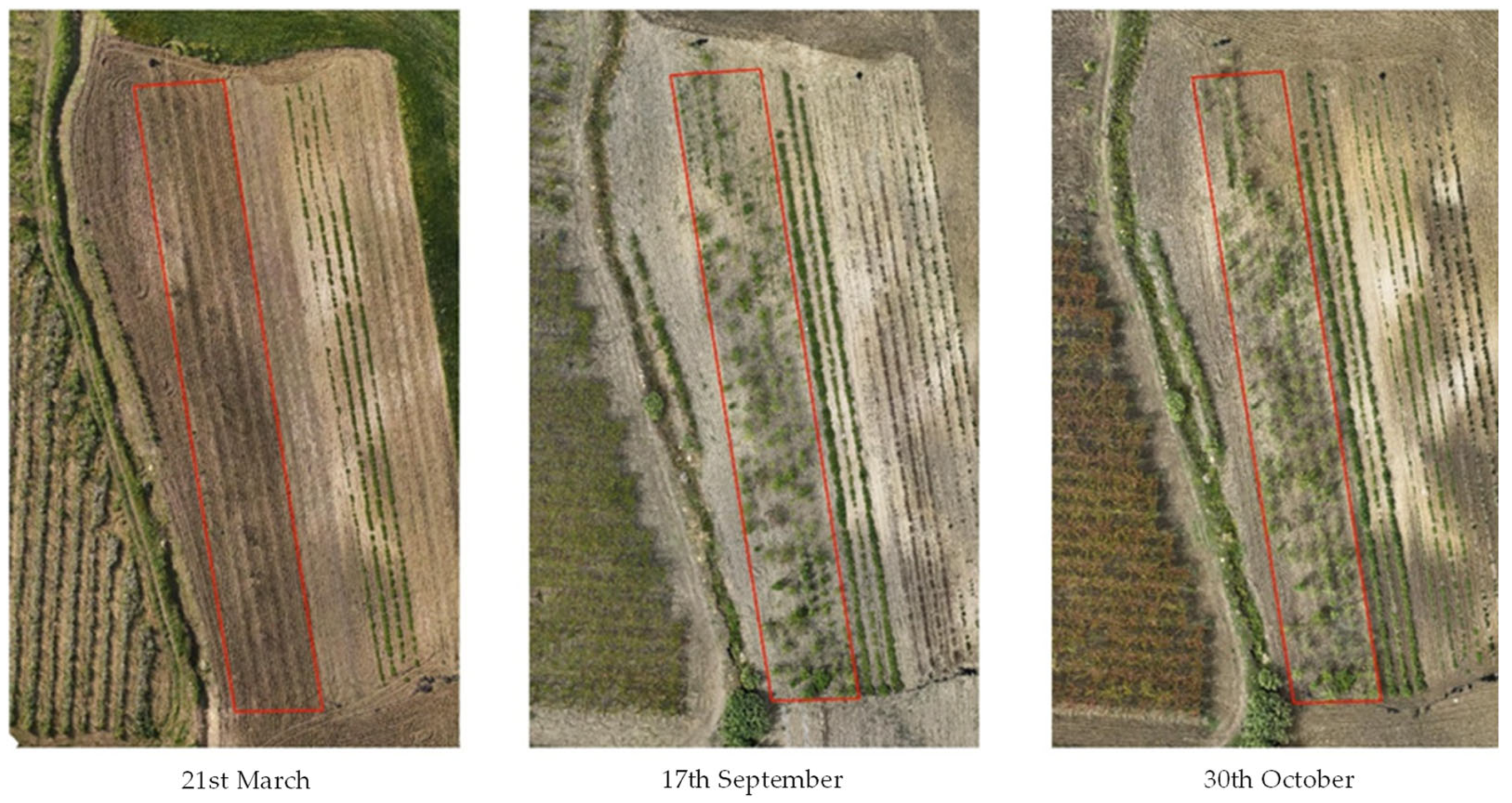
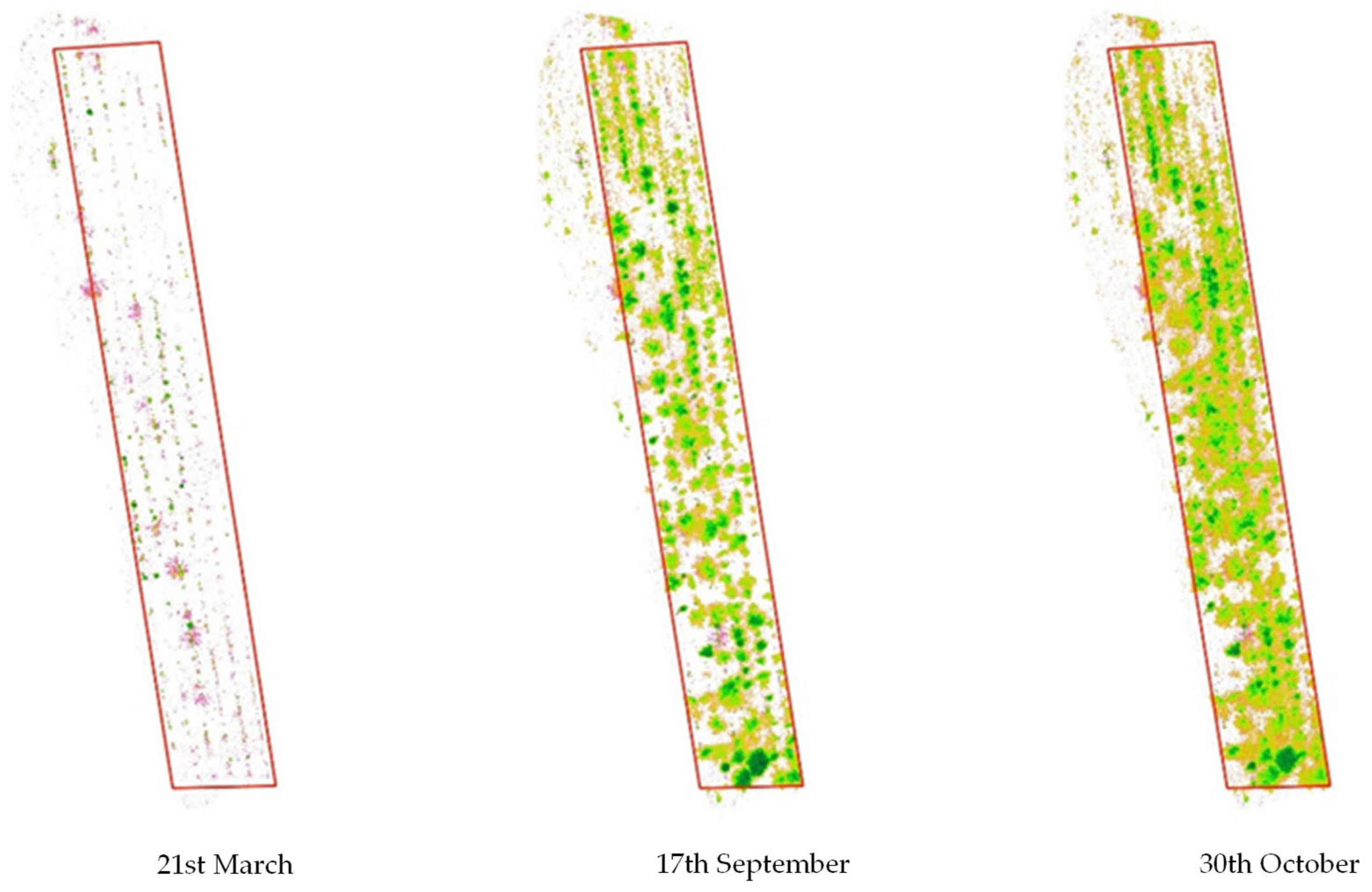
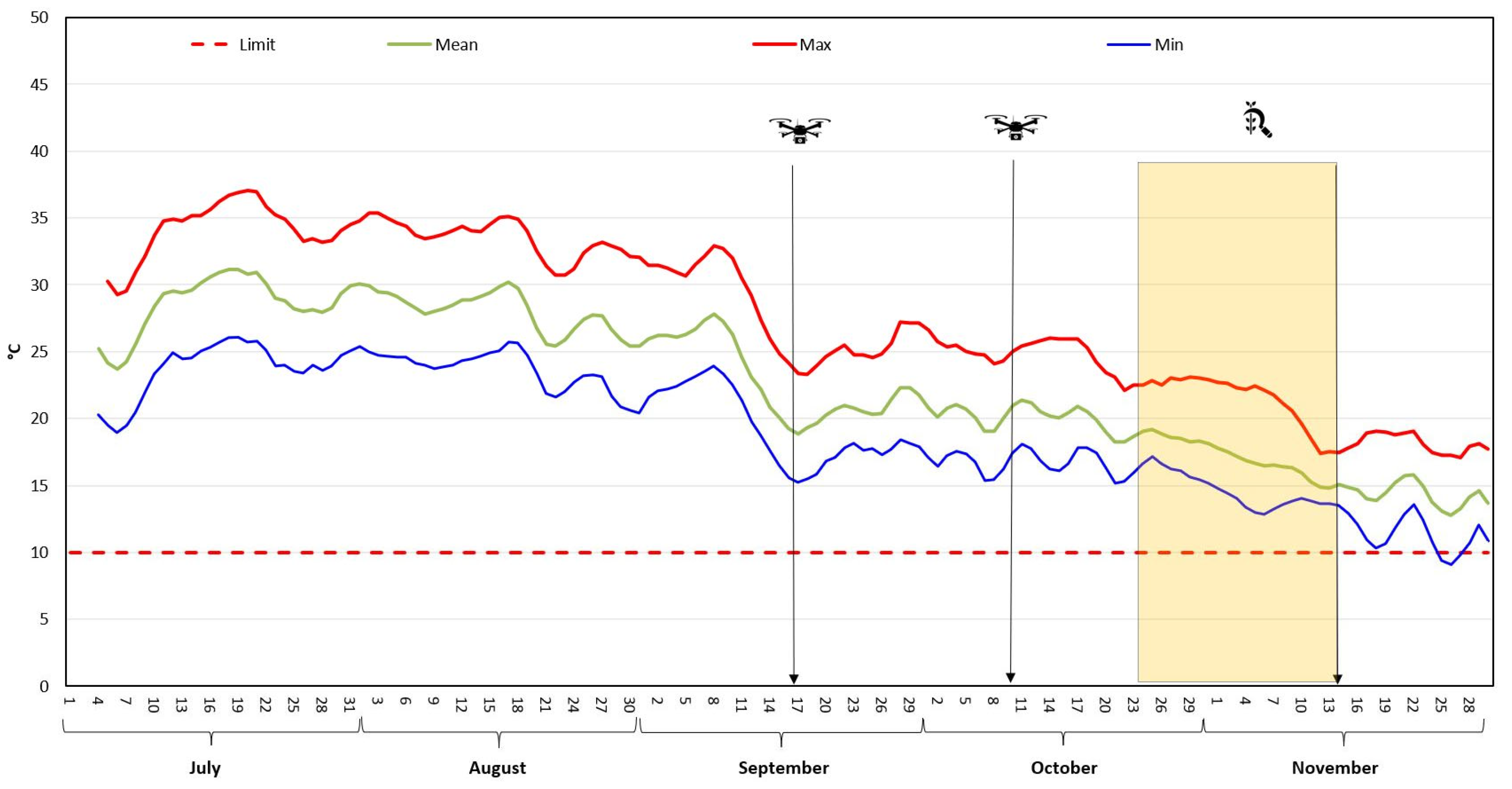
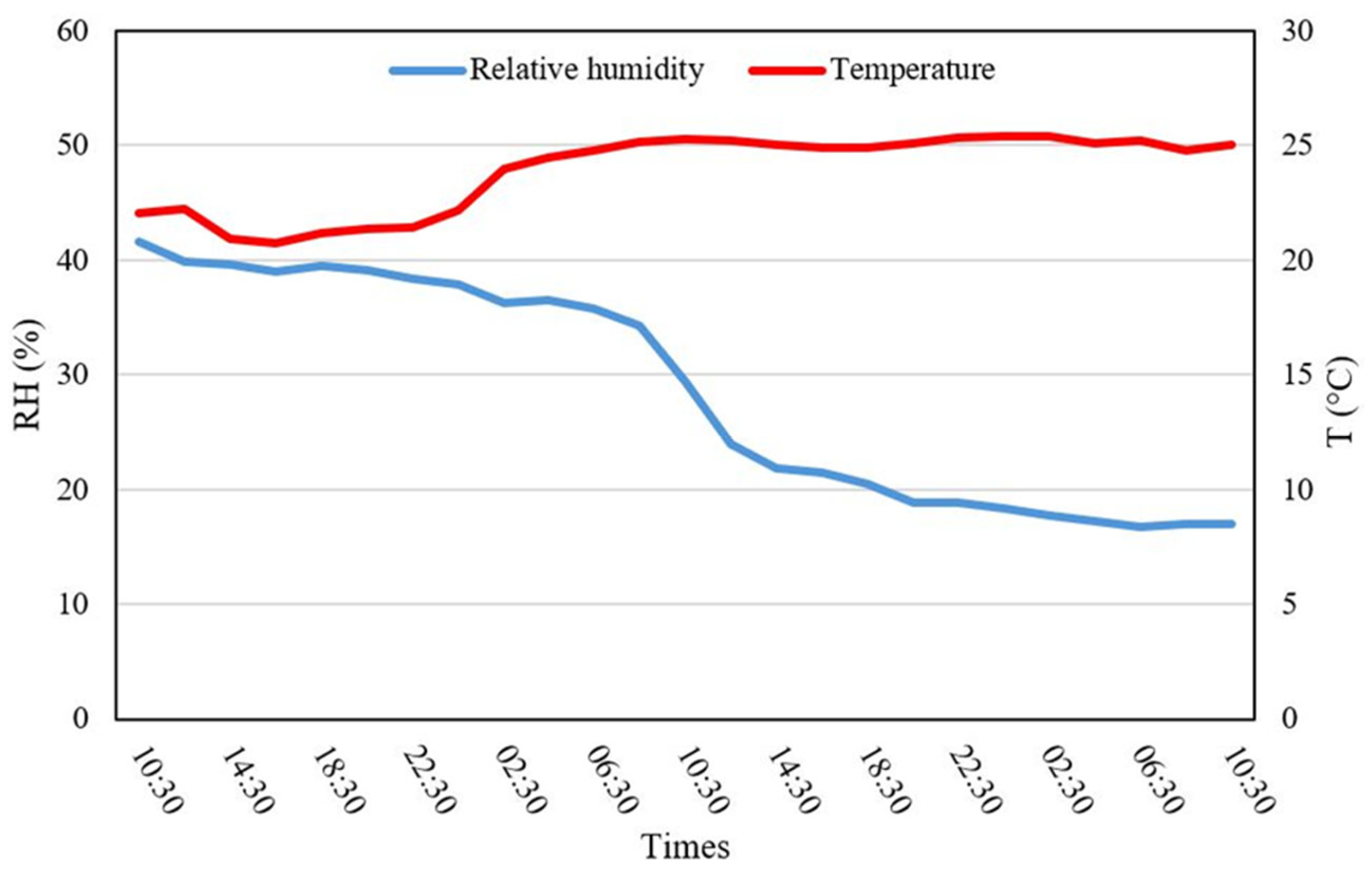
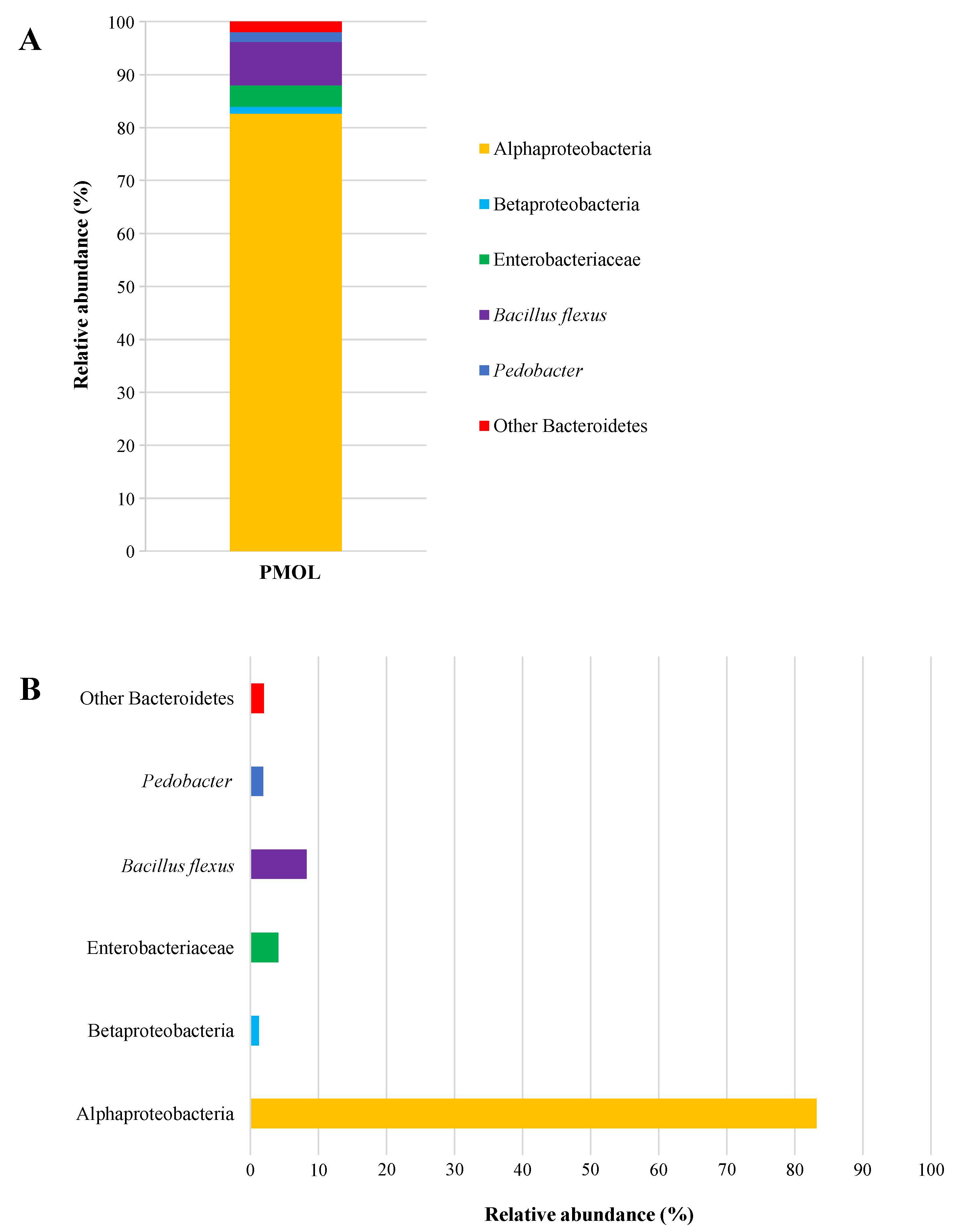
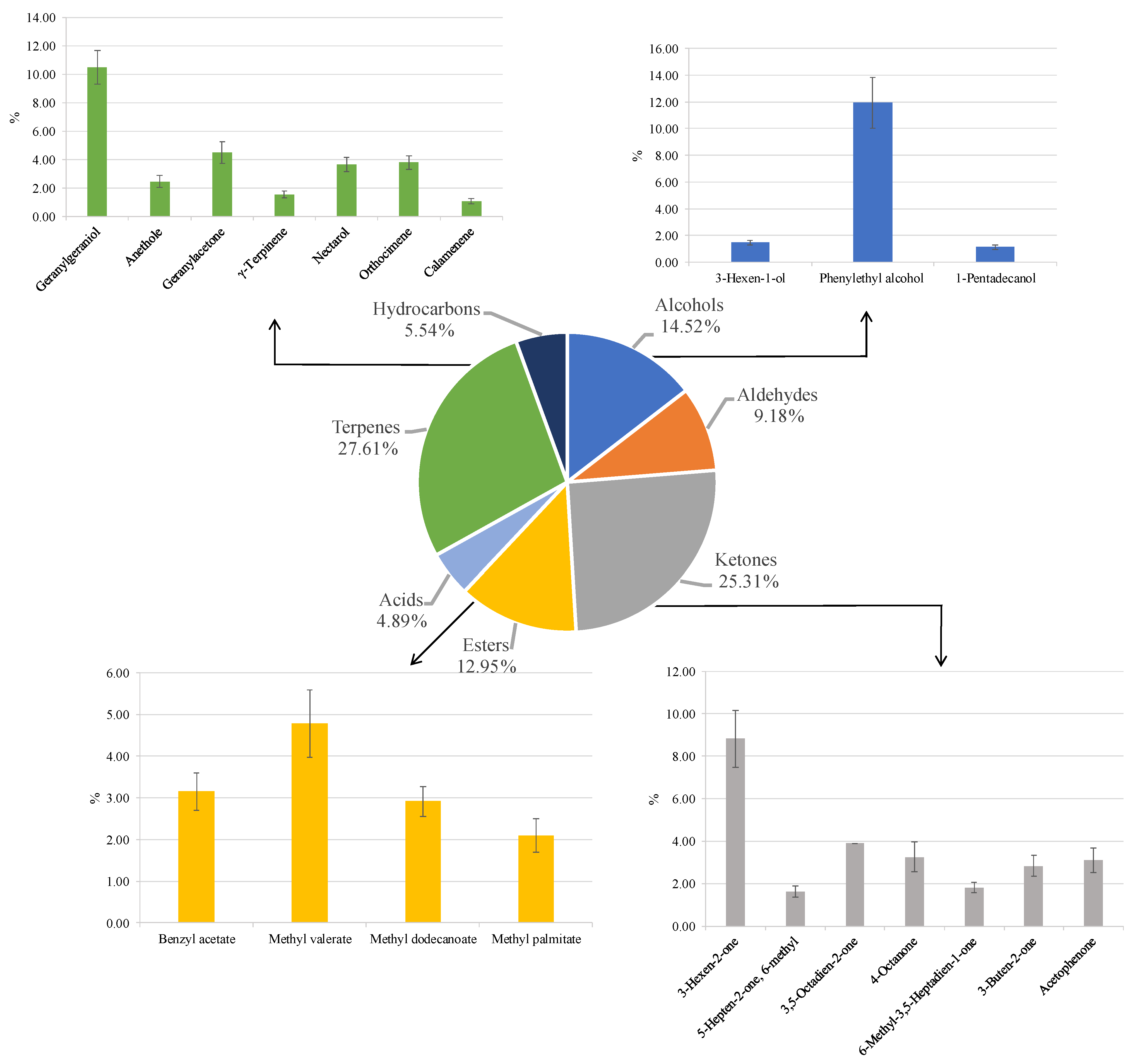
| RT (min) | MW (Da) | Chemical Formula | MS/MS (m/z) | Compound(s) | Amount (mg/100 g DW) |
|---|---|---|---|---|---|
| 3.12 | 191 | C7H12O6 | 191, 173, 127, 93, 85 | Quinic acid | 125.5 (3.104) |
| 9.01 | 353 | C16H18O9 | 191, 179, 135 | 3-Caffeoylquinic acid | 101.3 (3.834) |
| 12.96 | 353 | C16H18O9 | 191, 179, 173, 135 | 4-Caffeoylquinic acid | 36.2 (2.467) |
| 14.51 | 593 | C27H30O15 | 593, 473, 383, 353 | Vicenin-2 | 26.2 (1.803) |
| 18.35 | 354 | C16H18O9 | 191 | Chlorogenic Acid | 40.3 (1.194) |
| 20.42 | 609 | C27H30O16 | 609, 301, 300 | Quercetin-3-O-rutinoside | 24.7 (1.608) |
| 20.76 | 431 | C21H20O10 | 341, 311, 283 | Apigenin 8-C-glucoside | 48.6 (1.005) |
| 21.81 | 463 | C21H20O12 | 463, 301, 300 | Quercetin 3-O-glucoside | 70.1 (3.824) |
| 23.28 | 593 | C27H30O15 | 593, 285 | Kaempferol 3-O-rutinoside | 50.6 (2.303) |
| 24.68 | 447 | C21H20O11 | 447, 285, 284, 255 | Kaempferol 3-O-glucoside | 33.1 (1.179) |
| 25.37 | 477 | C22H22O12 | 477, 315, 314, 243 | Isorhamnetin 3-O-glucoside | 69.3 (2.361) |
| 27.89 | 283 | C15H10O5 | Apigenin | 12.4 (0.906) | |
| 28.12 | 286 | C15H10O6 | Kaempferol | 11.3 (0.731) | |
| 26.52 | 301 | C15H10O7 | Quercetin | 9.3 (0.666) |
| TPC | 2.86 ± 0.25 | g GAE per 100 g of DW |
| TCC | 1.64 ± 0.14 | mg BCE per 100 g of DW |
| Cha | 1.01 ± 0.04 | g Ch per 100 g of DW |
| Chb | 0.34 ± 0.02 | g Ch per 100 g of DW |
| DPPH• | 5.67 ± 0.49 | mmol TE per 100 g of FW |
| ABTS•+ | 8.06 ± 0.57 | mmol TE per 100 g of DW |
| FRAP | 15.71 ± 2.19 | mmol TE per 100 g of DW |
| CAA50 | 5.42 ± 0.43 | µg of DW per mL cell medium |
| HepG2 | 237.75 ± 4.37 c |
| Caco-2 | 182.36 ± 4.52 d |
| MCF-7 | 121.03 ± 3.71 a |
Disclaimer/Publisher’s Note: The statements, opinions and data contained in all publications are solely those of the individual author(s) and contributor(s) and not of MDPI and/or the editor(s). MDPI and/or the editor(s) disclaim responsibility for any injury to people or property resulting from any ideas, methods, instructions or products referred to in the content. |
© 2025 by the authors. Licensee MDPI, Basel, Switzerland. This article is an open access article distributed under the terms and conditions of the Creative Commons Attribution (CC BY) license (https://creativecommons.org/licenses/by/4.0/).
Share and Cite
Greco, C.; Serio, G.; Viola, E.; Barbera, M.; Mammano, M.M.; Orlando, S.; Franciosi, E.; Ciulla, S.; Alfonzo, A.; Schicchi, R.; et al. Exploring the Functional Properties of Leaves of Moringa oleifera Lam. Cultivated in Sicily Using Precision Agriculture Technologies for Potential Use as a Food Ingredient. Antioxidants 2025, 14, 799. https://doi.org/10.3390/antiox14070799
Greco C, Serio G, Viola E, Barbera M, Mammano MM, Orlando S, Franciosi E, Ciulla S, Alfonzo A, Schicchi R, et al. Exploring the Functional Properties of Leaves of Moringa oleifera Lam. Cultivated in Sicily Using Precision Agriculture Technologies for Potential Use as a Food Ingredient. Antioxidants. 2025; 14(7):799. https://doi.org/10.3390/antiox14070799
Chicago/Turabian StyleGreco, Carlo, Graziella Serio, Enrico Viola, Marcella Barbera, Michele Massimo Mammano, Santo Orlando, Elena Franciosi, Salvatore Ciulla, Antonio Alfonzo, Rosario Schicchi, and et al. 2025. "Exploring the Functional Properties of Leaves of Moringa oleifera Lam. Cultivated in Sicily Using Precision Agriculture Technologies for Potential Use as a Food Ingredient" Antioxidants 14, no. 7: 799. https://doi.org/10.3390/antiox14070799
APA StyleGreco, C., Serio, G., Viola, E., Barbera, M., Mammano, M. M., Orlando, S., Franciosi, E., Ciulla, S., Alfonzo, A., Schicchi, R., Piazzese, D., Gentile, C., Settanni, L., Mannino, G., & Gaglio, R. (2025). Exploring the Functional Properties of Leaves of Moringa oleifera Lam. Cultivated in Sicily Using Precision Agriculture Technologies for Potential Use as a Food Ingredient. Antioxidants, 14(7), 799. https://doi.org/10.3390/antiox14070799













